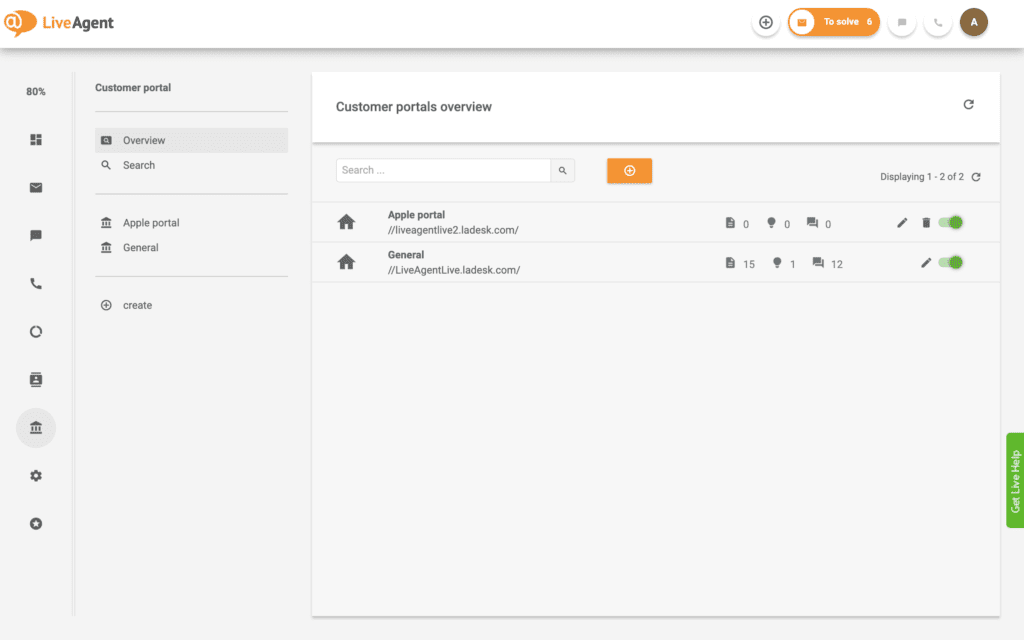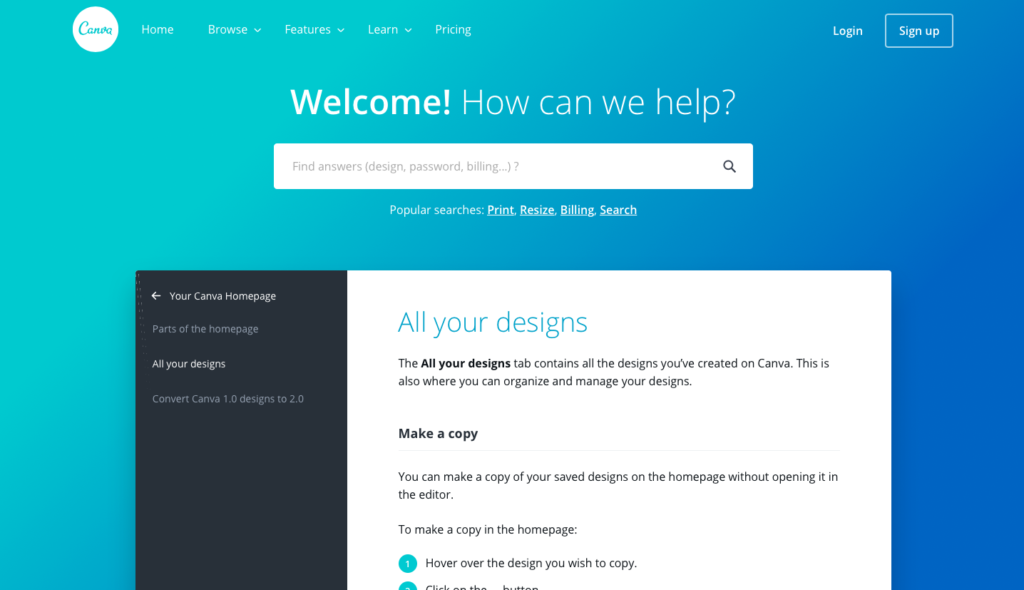- 电子邮件模版
- 知识库模板
知识库模板
全面的自助服务知识库是必备工具,提供结构和模板建议。知识库应有针对性、以用户为中心、全面且易读。了解写作步骤,选择正确标题,保持统一结构,添加视觉效果等。
随着数字化的深入,当今的线上消费者期待并要求能够轻松获取有关他们所使用的产品和服务的准确信息,拥有一个全面的自助服务知识库不再是“业内最好”,而是必须拥有的。实际上,Microsoft的研究表明,90%的全球消费者希望品牌和公司能够提供自助服务的在线门户。此外,根据Forrester的调查,与所有其他自助服务渠道相比,客户更喜欢使用知识库。下面是编写各种类型的有着一些基本知识的知识库文章简要指南。
什么是知识库?
知识库是一个在线的自助图书馆,包含了关于特定的公司、其产品或服务的文章和详细信息。它包括FAQ、答疑文章、故障排除技巧、用户指南和视频教程 – 还有任何可以帮助客户和潜在客户找到问题的答案并自行解决产品或服务问题(不涉及客户服务)的内容。
知识库可以为客户、潜在客户甚至员工提供有价值的数据。当使用外部知识库时,客户和潜在客户可以通过知识库了解关于公司产品或服务的所有信息。内部知识库可以用于内部分发公司的所有知识和信息。
写一篇有效的知识库文章的5个步骤
为了确保您的知识库是直接的、易读的、信息丰富且高度相关的,每一篇知识库文章都应该:
- 有针对性:每篇文章都应该坚持一个主题,避免用户感到困惑。
- 以用户为中心:只包含您的特定受众需要的内容。
- 全面的:含有简明的,详尽的,包罗万象的信息。
- 良好的框架: 保持一个简单的、标准化的结构,便于阅读。
- 良好的写作:使用简单易懂的语言,让非专业的用户能够理解。
- 视觉上的吸引:添加可视化内容,让用户更容易消化信息。
遵循以下简单的步骤,为您的知识库撰写文章:
选择正确的标题
创建一个合适的标题是重要的,要清楚地说明文章所处理的任务或问题。最好是基于指令或用户的期待去创建标题。因此,通过包含特定的关键词来保证标题简短并易于搜索,避免使用不必要的技术用语。以下是一些您可以使用的最常见的知识库文章的标题:
“以…作为开始”
“新用户指南”
“…指南”
“…简介”
“如何设置您的…”
“如何修复…”
“管理您的账户”
“安装您的…”
保持统一的结构
虽然结构可能会根据文章的类型而有所不同,但典型的知识库文章将包含简短的介绍、问题描述(如果适用的话)、完成任务步骤的简述、总结结果并列出相关链接。较长的文章可能还会包含一个目录,以帮助读者找到他们感兴趣的部分,并跳过任何不必要的信息。
易于阅读的格式
在格式化知识库文章时,简洁便是关键。为了让您的文章更容易被阅读,您可以考虑:
- 用不同的标题和副标题将较长的文章分成简短的段落;
- 包含一个带有锚链接的内容目录,这样用户可以直接跳转到与他们最相关的部分;
- 使用要点和序号来分开内容,使其更具有可读性;
- 使用粗体、斜体或高亮字体来吸引读者对关键信息的注意。
添加视觉效果
如果您正在一步一步地引导您的用户,您可以通过截图、GIF、视频或任何其他可以帮助您的读者更容易消化内容的方式让您的说明更加清晰。实际上,在编写任务导向的文案时,可视化是必须的,因为它们可以丰富您的支持内容,并有助于保持用户的参与度。
包含进一步的阅读建议
在文章的结尾提供相关的链接供读者进一步阅读,以帮助读者发现更多有用的信息。当用户可能想要了解更多和相关的主题有关的信息时,或者当您的文章只覆盖了一系列任务中的一个方面时,这一点就尤其重要。
“相关文章”
“延展阅读”
“相关链接”
“您可能也喜欢”
知识库文章模板
还不确定?别担心,我们已经创建了一些知识库文章模板来帮助您!
FAQ模板
FAQ是任何知识库的重要组成部分,因为它们能够解决最常见的问题。
Title: Frequently Asked Questions
Table of contents:
Section 1 (e.g. General Questions)
Question 1 (e.g. What is Company’s Product X?)
Question 2 (e.g. What are the benefits of Product X?)
Etc.
Section 2 (e.g. Features)
Question 1 (e.g. What features are included in the BASIC, PREMIUM, and PRO plans?)
Question 2 (e.g. What features does the trial include?)
Etc.
Section 3 (e.g. Billing Questions)
Question 1 (e.g. What is the monthly fee?)
Question 2 (e.g. How do I upgrade/ downgrade my subscription plan?)
Etc.
Answers:
Section 1
Question 1
Answer 1
Question 2
Answer 2
Etc.
Section 2
Question 1
Answer 1
Question 2
Answer 2
Etc.
Section 3
Question 1
Answer 1
Question 2
Answer 2
Etc.
知识库答疑文章模板
答疑文章帮助用户解决他们对您的产品或服务的问题。这些文章通常很简短,但非常的具体,并提供了执行某个任务的简要的步骤指南。
How to [Name of Task]
Task: [Brief description of a task to be completed]
(e.g. “By following the instructions, you’ll be able to …”
“This article will help you set up your …”
“The following guide will provide you with instructions on how to install …”)
Prerequisites (if applicable): [Brief description of which products/features/customers the task does/doesn’t apply to]
[Instructions:]
[Step 1]
[Step 2]
[Step 3]
[Etc. ]
Outcome: [Brief description of what should be possible once the task is completed]
Further Reading:
Related articles with links
故障诊断文章模板
故障诊断文章需要帮助用户解决他们可能遇到的与您的产品或服务相关的更复杂的问题。它与指南类的文章非常相似,但是,它们侧重于在出现问题时提供解决方案,而不是教育用户如何完成任务或如何最大限度的利用产品的功能。
Title: [Problem name]
Problem: [Brief description of the problem to be addressed]
Overview of possible solutions
[Solutions:]
[Solution 1]
[Solution 2]
[Solution 3]
[Etc. ]
Outcome: [Brief description of how to confirm the problem is solved]
Alternatives: [Explaining the next steps if the problem isn’t solved]
(e.g. “If none of these actions work, please call our customer support at (number) or start a live chat.”
“If none of the described steps helped, please send us an email at (email) or call our tech support at (number).”)
Further Reading:
Related articles with links
工具描述模板
工具描述文章对具体的产品/服务进行了简短的描述。它们告诉读者产品/服务是如何运作的,而不是回答问题或列出步骤说明。此外,它们还可能包括一些关于该工具的功能和好处的信息,并解释为什么这值得购买。
Title: [Product/ Service]
[Brief introduction of tool]
[Description of tool]
[Final tips/Additional information to note about the tool]
Further Reading: Related articles with links
用户指南模板
用户指南或用户手册通常是长的、详细的、全面的文章,以提供整个产品或服务的描述。它们包含使用的每一个功能的完整信息,为用户提供关于产品或服务的全面教育。大多数用户指南包括文字的指南和相关的图片(截图和图表等)。
Title: A Guide to [Product/ Service]
[Brief introduction of product/ service]
[Main Feature 1: Description]
[Sub-Feature 1: Description]
[Sub-Feature 2: Description]
[Sub-Feature 3: Description]
[Etc.]
[Main Feature 2: Description]
[Sub-Feature 1: Description]
[Sub-Feature 2: Description]
[Sub-Feature 3: Description]
[Etc.]
Further Reading:
Related articles with links
教程模板
教程与具有步骤说明的答疑文章非常相似,但是,它们提供更加深入的信息,步骤的说明并不总是基于时间顺序。此外,教程还可以包含结构化的、完整的解释,以说明用户可以对特定的产品、服务或功能做些什么,以及相关的视觉效果(截图、视频等)。
Title: What is [product/service/feature?]
Use case 1
Explanation
Screenshot/ video
Tips to use it this way:
Tip 1
Tip 2
Use case 2
Explanation
Screenshot/ video
Tips to use it this way:
Tip 1
Tip 2
Further Reading:
Related articles with links
Ready to put our knowledge base article templates to use?
LiveAgent is the most reviewed and #1 rated help desk software for small to medium-sized businesses. Try building a knowledge base today with our free 14-day trial.<br> No credit card required.
知识库模板 – 常见问题
知识库的目的是什么?
知识库是一个以提供问题答案和解决问题为目的的知识仓库。
为什么您要有一个知识库?
知识库是客户服务和支持的必要工具。它为客户提供可搜索的知识和解决常见问题的信息。
您应该拥有哪些类型的知识库文章?
您可以在知识库中使用以下类型的文章:FAQ文章来帮助回答常见的客户服务问题。提示文章则提供了解决常见的客户服务问题的快速提示。答疑文章提供了执行特定任务的步骤指导。警告文章提醒了客户注意潜在的危险和问题。
{ “@context”: “https://schema.org”, “@type”: “FAQPage”, “mainEntity”: [{ “@type”: “Question”, “name”: “知识库的目的是什么?”, “acceptedAnswer”: { “@type”: “Answer”, “text”: “知识库是一个以提供问题答案和解决问题为目的的知识仓库。” } }, { “@type”: “Question”, “name”: “为什么您要有一个知识库?”, “acceptedAnswer”: { “@type”: “Answer”, “text”: “知识库是客户服务和支持的必要工具。它为客户提供可搜索的知识和解决常见问题的信息。” } }, { “@type”: “Question”, “name”: “您应该拥有哪些类型的知识库文章?”, “acceptedAnswer”: { “@type”: “Answer”, “text”: “您可以在知识库中使用以下类型的文章:FAQ文章来帮助回答常见的客户服务问题。提示文章则提供了解决常见的客户服务问题的快速提示。答疑文章提供了执行特定任务的步骤指导。警告文章提醒了客户注意潜在的危险和问题。” } }] }You will be
in Good Hands!
Join our community of happy clients and provide excellent customer support with LiveAgent.

我们的网站使用cookies。点击继续我们将默认为您允许我们将cookies部署在我们的网站上。 隐私和cookie政策.

 Български
Български  Čeština
Čeština  Dansk
Dansk  Deutsch
Deutsch  Eesti
Eesti  Español
Español  Français
Français  Ελληνικα
Ελληνικα  Hrvatski
Hrvatski  Italiano
Italiano  Latviešu
Latviešu  Lietuviškai
Lietuviškai  Magyar
Magyar  Nederlands
Nederlands  Norsk bokmål
Norsk bokmål  Polski
Polski  Română
Română  Русский
Русский  Slovenčina
Slovenčina  Slovenščina
Slovenščina  Tagalog
Tagalog  Tiếng Việt
Tiếng Việt  العربية
العربية  English
English  Português
Português 








